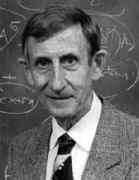Person: Dyson, Freeman John

Freeman Dyson was an English theoretical physicist and mathematician who worked in quantum electrodynamics, solid-state physics and astronomy. He worked in America for many years.
Mathematical Profile (Excerpt):
- At the time of Freeman's birth George was teaching music at Wellington College in Berkshire.
- Freeman attended a day school run by Miss Scott from the time he was five years old.
- Despite the fact that the school was so close to his home, Freeman only went home in the school holidays and his parents never visited him in the school.
- In 1936 Dyson won first place in a scholarship examination to Winchester College; he was twelve.
- Winchester College was important for freeman for it gave him an outstanding mathematical education.
- Foreign languages came easily to Dyson and when he became interested in number theory in 1938 he decided to read An introduction to the theory of numbers by Vinogradov.
- Dyson gained a scholarship to Trinity College, Cambridge in 1941.
- Dyson had three papers published in 1943, Three identities in combinatory analysis and On the order of magnitude of the partial quotients of a continued fraction are consecutive papers in the Journal of the London Mathematical Society while A note on kurtosis appeared in the Journal of the Royal Statistical Society.
- Although not a particularly happy time for Dyson he did have a couple of good friends.
- In 1943 Dyson, despite earlier pacifist beliefs, started work as a scientist with Bomber Command where he worked on increasing mission efficiency.
- At the end of the war, Dyson took a job as a demonstrator at Imperial College.
- Dyson worked closely with Bethe and became deeply impressed by him (as all Bethe's students were.) In 1948 Dyson published a paper on Lamb shift in Physical Review called The Electromagnetic Shift of Energy Levels.
- It is clear that at this time Dyson was considered to be an extraordinarily gifted and able student.
- Bethe persuaded Oppenheimer to take Dyson on at the Institute for Advanced Study at Princeton.
- It was from this time that Dyson's work focused on quantum electrodynamics.
- Something happened at this time that greatly pleased Dyson; Tomanaga in Japan had developed significant work in relativistic quantum field theory.
- Around spring in 1948, Dyson and Feynman became friends and Dyson became familiar with Feynman's methods.
- After a long bus ride to Princeton Dyson famously figured out a very significant problem that had bothered him during the year.
- Dyson arrived at Princeton in the Autumn of 1948.
- Bethe continued to be a real support to Dyson and at an influential seminar helped Dyson persuade the audience (which including Oppenheimer) that Feynman's methods were the most promising way to proceed.
- Dyson's famous paper on renormalisation of the SSS-matrix The S matrix in quantum electrodynamics in 1949 became a very highly regarded and influential work in quantum electrodynamics.
- Dyson started to become a celebrity in scientific circles.
- In the summer of 1949 Dyson met Verena Esther Haefeli-Huber at the Institute for Advanced Study.
- George Dyson left home at age 16, moved to British Columbia where he built canoes, explored the Northwest Coast, and made his home in a tree-house.
- After finishing the SSS-matrix paper, Dyson turned to meson theory where he devised a method of separating the calculation of high and low frequency interactions.
- After further important publications and contributions to international conferences, in May 1950 Dyson took over Feynman's professorship at Cornell.
- Bethe's admiration for Dyson had by now become great.
- Bethe stated that Dyson was "the only man in the world " who could replace Feynman at Cornell.
- It is amusing to note that at no point during Dyson's impressive career did he appear to obtain a Ph.D. It just did not figure in the scheme of things.
- In 1953 Dyson accepted a post as professor of physics at Institute for Advanced Study, Princeton.
- We remarked above that Dyson continued to publish research papers on pure mathematics despite now being a physicist.
- We should give special mention to the paper A walk through Ramanujan's garden which Dyson published in 1988.
- Dyson has also published several books on science/philosophy, including Disturbing the Universe (1979), Weapons and Hope (1984), Origins of Life (1986), Infinite in all Directions (1988), From Erod to Gaia (1992), Imagined Worlds (1997) and The Sun, the Genome and the Internet (1999).
- Dyson has received many honours for his outstanding contributions including election to a fellowship of the Royal Society of London in 1952.
- In 1994 Dyson retired from his professorship at the Institute for Advanced Study at Princeton and was appointed professor emeritus.
- In 1996 Selected papers of Freeman Dyson with commentary was published by the American Mathematical Society.
- Dyson's versatility, mathematical strength and depth are well known and his comments and sometimes provocative opinions are thought-inspiring and a pleasure to read.
Born 15 December 1923, Crowthorne, Berkshire, England. Died 28 February 2020, Princeton, New Jersey. USA.
View full biography at MacTutor
Tags relevant for this person:
Origin England
Thank you to the contributors under CC BY-SA 4.0! 

- Github:
-

- non-Github:
- @P-Lindsay
- @J-J-O'Connor
- @E-F-Robertson
References
Adapted from other CC BY-SA 4.0 Sources:
- O’Connor, John J; Robertson, Edmund F: MacTutor History of Mathematics Archive
